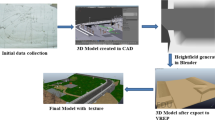Abstract
In the light of the problems that exist in the current cutting algorithms: first, the number of tetrahedron elements increases as the cutting goes on, which leads to the decrease of the algorithm efficiency. Second, the topology structure is constantly updated during the cutting process, which leads to the stutter phenomenon in cutting display. In this paper, a cutting simulation implementation method based on transient display and delay adjustment strategy is proposed. Firstly, the feature points in the original path are screened by the feature criterion function, and the feature path is established. Then, by using the concept of minimum sum of square defined in this paper, the optimal path of the separation is found with the help of feature path points, and the pseudo effect of cutting is directly displayed by designing the transient display module. The delay adjustment is carried out in the cutting gap, and the topology separation in the delay adjustment is implemented by the node offset spread algorithm and the duplicate removal process with timeliness. Finally, the advantages and feasibility of the cutting algorithm proposed in this paper are verified by practical tests. The test results show that the transient display algorithm proposed in this paper takes about 20 ms. With the number of triangular patches increasing, the growth rate of transient display time remains low. The cutting simulation is implemented by using transient display and delay adjustment strategy, which greatly improves the simulation efficiency.














Similar content being viewed by others
References
Liao, Z. F., Huang, X. Y., & Yu, S. (2010). Cutting of soft tissue in virtual surgery system. Software guide (pp. 14–16).
Morten, B. N. (1998). Finite element modeling in surgery simulation. In Proceeding of the IEEE.
Yang, J., Yu, L., & Wang, L. (2016). Study on mechanical characterization of liver tissue based on haptic devices for virtual surgical simulation. Journal of Mechanics in Medicine and Biology, 16(08), 1–10.
Wang, M. N., Wang, L., Li, P. C., & Fu, Y. L. (2017). A novel modeling and simulation method of hip joint surface contact stress. Bioengineered, 8(1), 105–112.
Wang, M. N., & Yang, N. (2017). A review of bioregulatory and coupled mechanobioregulatory mathematical models for secondary fracture healing. Medical Engineering and Physics, 48, 90–102.
Steinemann, D., Otaduy, M. A., & Gross, M. (2006). Fast arbitrary splitting of deforming object. In Proceedings of ACM SIGGRAPH symposium on computer animation (pp. 63–72). Dublin: Eurographics Association.
Molino, N., Bao, Z., & Fedkiw, R. (2014). Virtual node algorithm for changing mesh topology during simulation. ACM Transactions on Graphics, 23(3), 385–392.
Courtecuisse, H., Jung, H., & Allard, J. (2010). GPU-based real-time soft tissue deformation with cutting and haptic feedback. Progress in Biophysics and Molecular Biology, 103(2–3), 159–168.
Courtecuisse, H., Allard, J., & Kerfriden, P. (2014). Real-time simulation of contact and cutting of heterogeneous soft-tissues. Medical Image Analysis, 18(2), 394–410.
Wang, M. N., Sun, L., Yang, N., & Mao, Z. Y. (2016). Fracture healing process simulation based on 3D model and fuzzy logic. Journal of Intelligent and Fuzzy Systems, 31(6), 2959–2965.
Wicke, M., Botsch, M., & Cross, M. (2007). A finite element method on convex polyhedral. Computer Graphies Forum, 26(3), 355–364.
Liu, G. R., Gu, Y. T., Wang, J. M., & Zhou, X. J. (2007). An introduction to meshfree methods and their programming. Shandong: Journal of Shandong University.
Guo, X. H., Li, X., & Bao, Y. F. (2006). Meshless thin-shell simulation based on global conformal parameterization. IEEE Transactions on Visualization and Computer Graphics, 12(3), 375–385.
Jung, H., & Lee, D. Y. (2012). Real-time cutting simulation of meshless deformable object using dynamic bounding volume hierachy. Computer Animation and Virtual Worlds, 23(5), 489–501.
Acknowledgements
This research was supported by National Natural Science Foundation of China (No. 61572159), Scientific Research Foundation for the Returned Overseas Scholars of Heilongjiang Province and Harbin University of Science and Technology Youth Talent Support Program.
Author information
Authors and Affiliations
Corresponding author
Ethics declarations
Conflict of interest
Both authors declare that they have no conflict of interest.
Rights and permissions
About this article
Cite this article
Wang, M., Mao, Z. Implementation Method of Cutting Simulation Based on Transient Display and Delay Adjustment Strategy. Wireless Pers Commun 103, 25–40 (2018). https://doi.org/10.1007/s11277-018-5423-0
Published:
Issue Date:
DOI: https://doi.org/10.1007/s11277-018-5423-0




